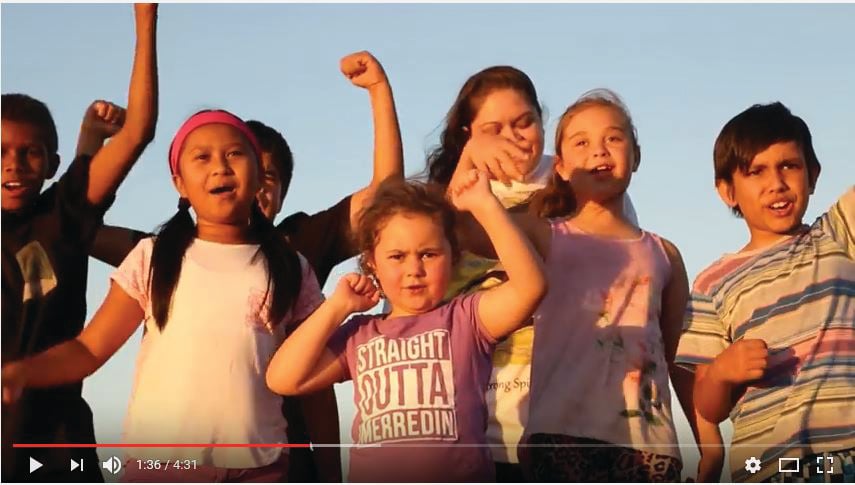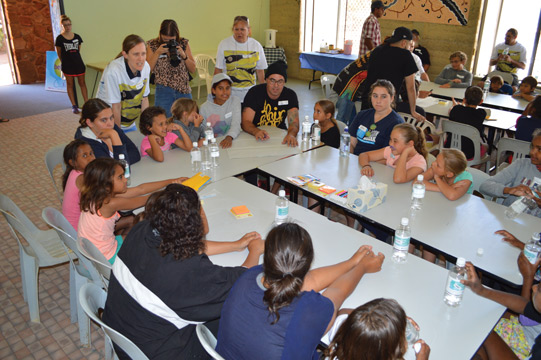An innovative program set to run for about two and a half years aims to halve the number of children affected by skin infections − a major cause of health problems in remote Aboriginal communities.
The SToP program (See, Treat and Prevent) is a partnership between The Kids Research Institute Australia, Western Australia Country Health Service-Kimberley and Kimberley Aboriginal Medical Services.
The ‘see, treat and prevent’ approach will put resources in place to help diagnose skin infections; assess the effectiveness of new treatments identified in clinical trials; and boost prevention through health promotion and environmental health activities driven by each community.
Paediatric infectious diseases specialist Dr Asha Bowen, from the Institute’s Wesfarmers Centre of Vaccines and Infectious Diseases, said it was vital to educate health-care workers, parents and the community to identify the problem so that more children could be properly diagnosed.
One study had revealed that many children presenting to hospital were not picked up as having skin infections – missing a golden opportunity to treat them to avoid later complications.
Skin infections can lead to life-threatening conditions such kidney disease, rheumatic heart disease, bone infections and blood poisoning.

Dr Bowen said the program would also incorporate the latest treatment from two recently published trials.
“These showed that treatment with a short course of oral antibiotics is just as effective for school sores as the standard treatment, which is a painful injection of penicillin,” she said.
“The other study showed that ivermectin, a tablet, was more effective for treatment of scabies than the traditional approach of applying an oily, topical cream all over the body. Testing whether these approaches work in the Kimberley to reduce the overall burden of skin infections by 50 per cent will be an important extension of these big trials.”
The availability of alternative treatments is an important step after an earlier study in the Pilbara revealed many children were reluctant to attend clinics because of the penicillin injections.
About 40 per cent of all Aboriginal children in remote areas are affected by skin sores at any one time –- the highest prevalence in the world. Scabies is also endemic in some communities, with up to one-third of children affected.
“Our current skin infection research aims to address the burden through implementing the latest evidence-based treatment regimens, whilst building the environmental health, training and health promotion components that are critical to effective management of skin infections,” Dr Bowen said.
In a project aimed at educating people about the importance of healthy skin spearheaded by indigenous health worker Marika Hayden, children from the Njaki Njaki community in Merredin have created a hip-hop music video called Gotta Keep It Strong.
“There were about 40 Aboriginal children and their families in a community hall learning about skin infections and then writing the lyrics of the songs,” Dr Bowen said. “During this time, a few of the kids realised they had a skin infection and called me over to check it out. One even needed to go to hospital to get treatment. It was great to see them translating what they were learning directly into seeking help for their own skin problems.
“The key message in Gotta Keep It Strong is that the skin is important for health, identity, culture and family.”
The video will also hopefully tackle the perception that because so many children get skin infections so frequently, everyone thinks it is normal.
The Kids Research Institute Australia is also involved in developing national guidelines for the clinical care and control of skin infections.
“These will mean that we have a consistent approach to treatment of skin infections whether you are a patient in Broome in WA, Alice Springs, NT, or Moree in NSW,” Dr Bowen said.
Other studies are investigating the burden of skin infections in hospitalised children and working to understand the concurrent burden of Group A streptococcus-related skin and throat infections, with the aim of determining the best strategy for primary prevention of acute rheumatic fever.
What’s next?
- Continue to reduce the burden. “Even if we successfully halve the current burden, we will still have one in five kids affected by skin infections at any one time. That is still unacceptably high. The Kimberley goal is less than 5 per cent.”
- Use the resources and lessons from the SToP programacross the north of Australia to reduce the burden in other areas through the Hot North partnership.
- Monitor the risk of antibiotic resistance to inform the next phase of research, such as whether a new form of treatment will be needed.
 Workshops in Merredin
Workshops in Merredin
Skin sores & scabies
- Impetigo, also known as school sores or skin sores, is a highly contagious type of skin infection caused by the Staphylococcus or Streptococcus bacteria. More common in the hotter months, the infection is easily spread and is characterised by inflamed blisters that pop, weep and form crusts.
- Scabies is a skin infestation caused by mites which burrow into the skin to lay their eggs. It leads to red bumps or blisters on the skin that are very itchy. If scratched, it can allow a strain of Streptococcus or Staphylococcus bacterium to cause infection.
